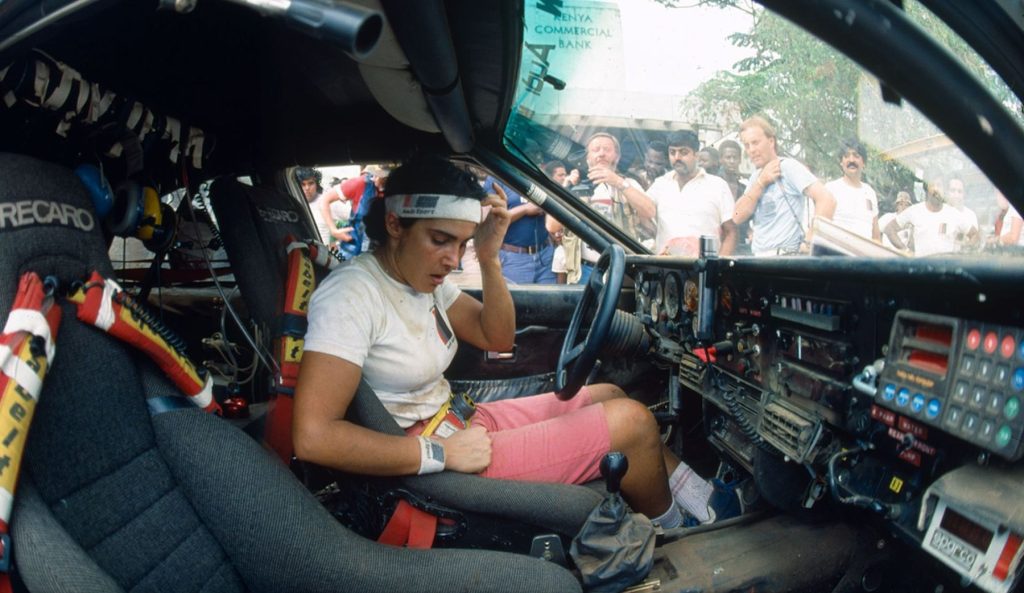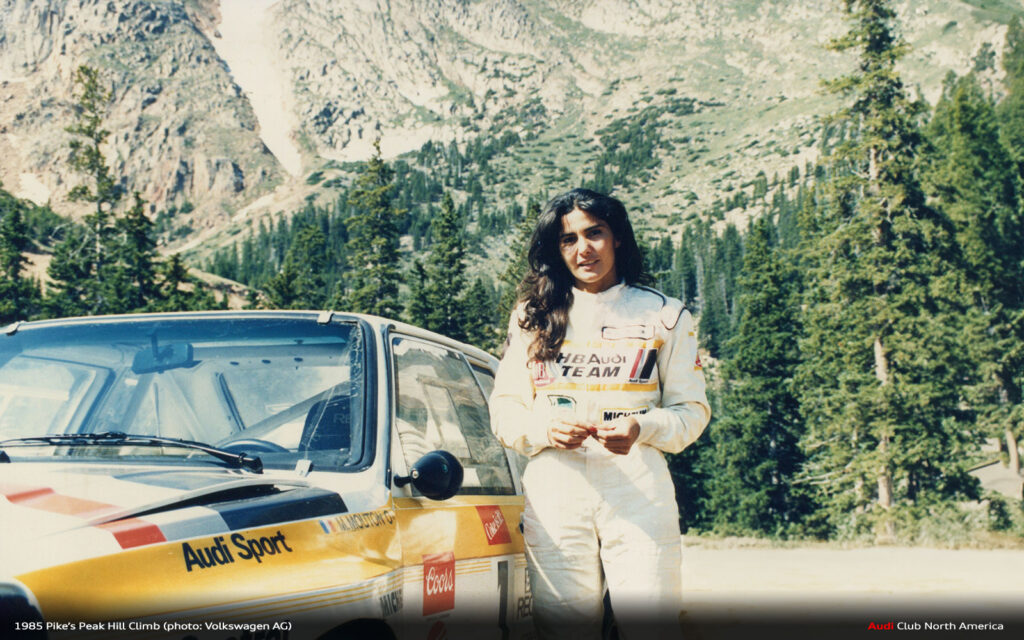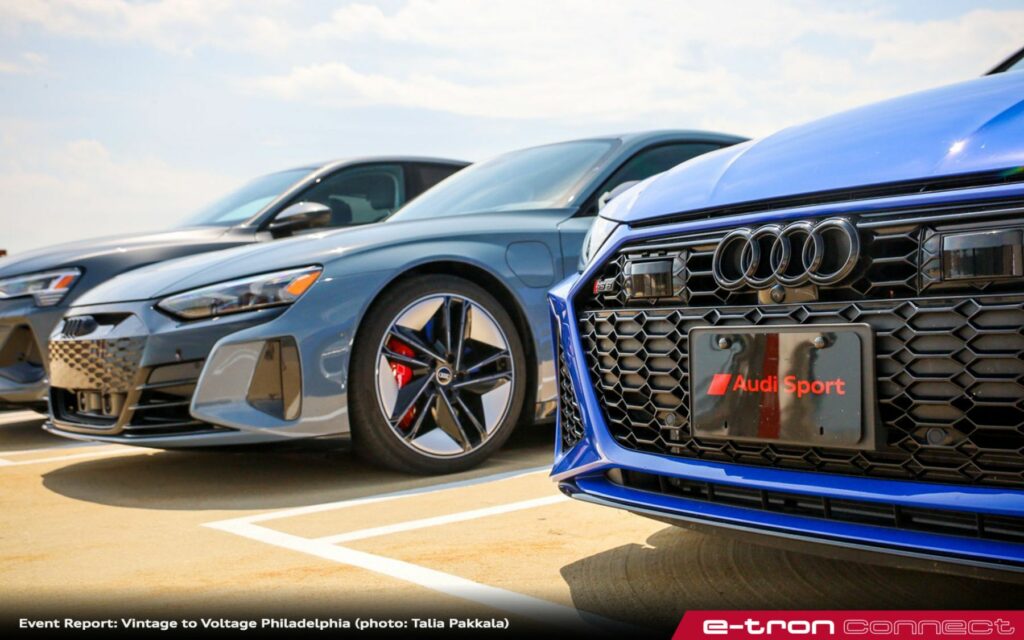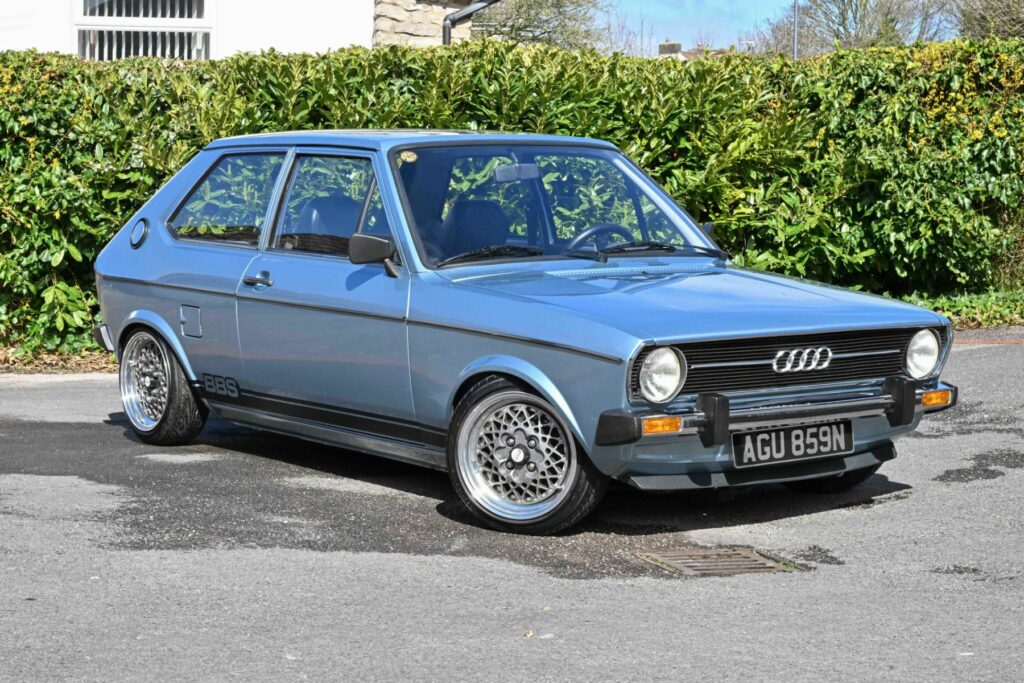
quattro Magazine: A Time to Rally – Michèle Mouton & the 1982 Rallye Côte d’Ivoire
words: George Achorn, photos: Audi Tradition
Editor’s Note: This article originally ran in the Q3_2023 issue of quattro Magazine. If you would like to subscribe to quattro Magazine, please join Audi Club here.
Abidjan, Ivory Coast – Mornings at the Hotel Ivoire are typically not so busy as they were at 7 AM on Wednesday October 27, 1982. A modern hotel situated near the shore of Ivory Coast’s economic capital, the venue is a central hub of activity on most days – especially when the Rallye Côte d’Ivoire is in town. On that morning, key World Rally Championship (WRC) teams were prepping for departure and Michèle Mouton was taking some last-minute television interviews before her scheduled 10 AM start. The 32-year-old Mouton was in the title hunt and could clinch the driver’s championship with her Audi quattro here in Ivory Coast if things went her way – a first for a woman at this level of motorsport.
That’s all anyone wanted to talk about. The spotlight and focus on her seemed constant and unending. As the television crew was wrapping up, Michèle was informed she had a call coming in from France. Picking up the phone, she heard the words nobody ever wants to hear… much less three hours before the start of such a grueling race with a championship on the line. Her mind must have raced, memories flooding back.
Ten years earlier and at the late age of 22, Michèle had discovered an interest in racing. She’d entered a few rallies as co-driver for a friend. Michèle’s father showed up at one of those races and he wasn’t pleased with what he’d found. Her friend’s car had nearly bald rear tires, which didn’t bode well for his daughter’s safety. If Michèle was going to continue with rally, he would purchase her a car and she would drive for herself.
So came her first car, and with it she found success… something that did not please her male competitors. Allegations of an illegal car followed victories. After winning her Group 3 class at Corsica in 1975, officials required a full tear down inspection of her engine. Nothing was found and the victory stood, but then came the raft of excuses (other than obvious skill) why this girl was able to beat them.
One thing led to another, and eventually a WRC team seat with Audi and its bar-re-setting quattro for Audi’s inaugural 1981 season campaign was offered.

For Michèle who’d grown up in the south of France, the stoic German Audi team proved a bit of a cultural challenge. In those days, she was quoted as saying, “People say I am nervous but it’s not true. If I’m not happy with someone then they know immediately. It is my character. I think for the Audi mechanics it was maybe a long time to understand me. They were thinking I was always shouting.”
Mouton’s co-driver Fabrizia Pons saw it a different way. In the 2021 documentary Queen of Speed, Pons noted, “The strength of Michèle was her character. She was very demanding with everybody. With me. With the team. But with herself too.”
Learning the nuances of driving the quattro was also a challenge. With this, her teammate Hannu Mikkola set competition aside to share what he’d learned. Left-foot braking was new to Mouton, but Mikkola had more experience with the quattro and taught her that keeping the car on throttle, and thus on boost, would greatly improve performance. Michèle proved a quick study and picked up pace so noticeably that her detractors again attributed gains to the car rather than its driver.
Mikkola knew differently. He could see her times were just as good, sometimes better, than his own. In an interview with Road & Track back then, Mikkola said, “I don’t think the journalists, or many of the drivers, realize just how good she is. They blame the car for her success – it is incredible, and she is just along for the ride. That’s not how it is; I know, I have to drive against her, and I know what speed she is doing. She is fantastic! She learns too fast!”
Michèle drove that point (and the quattro) home in San Remo that year, logging her first outright victory… the first ever for a woman in the WRC and only Audi Sport’s second since the quattro’s racing debut. In attendance was her father, the very person who’d been instrumental in her shift from co-driving hobbyist to applying herself fully to her passion.
After San Remo is when things got crazy. Crowds were growing, and with much more focus on Michèle Mouton. Her first contract may have been more promotional, to put a woman in the seat. Here she was though, dominant, and winning rallies over proven drivers including her veteran teammates. No doubt it was above and beyond what Audi had expected, and the media attention became a circus. Michèle and Fabrizia soon tired of comments about their appearance or being girls. They wished to be seen simply as drivers, without the need to constantly mention their gender.
When it came time to renew that first year’s contract, Michèle was shrewd. Sitting down over contract negotiations with the lawyers, she said it was all very simple. “You just need to double it.”
The stakes were raised. Audi had increased its investment in Mouton and had already spent so much on the quattro racing program. Like the plight of its driver, the car wasn’t just a pretty face. Audi aimed to prove quattro’s substance, but to do so meant they and their star drivers would need to overcome some serious competition.
Chief among them was Walter Röhrl. The German driver had won the championship in 1980 with Fiat. Now, in 1982, he found himself contracted with Opel and its rear-wheel drive Ascona. Walter was famously cerebral and logical, even coming to be known as “The Computer.” Highly respected, he preferred rally where it is the driver versus the course, and not elbows out versus other drivers. Perfection in performance is what he relished, and that’s exactly what rallying called for.

The 1982 season didn’t start well for Michèle. Though the first round at Monte Carlo was her home race, a hard accident placed her out of contention. While she temporarily nursed herself on crutches, Röhrl walked away with the win.
In round three the teams moved to Portugal, where drivers received a rock star reception. Thick crowds lining the route are commonplace, even in the woods where macho male fans try to touch the cars as they pass. To manage the challenge mentally, Michèle began to imagine them as trees, knowing that if she made a mistake, it could be fatal for fans or for herself if she hit an actual tree. As they passed through towns, it wasn’t men who lined the road but women who came out of their homes and jobs to cheer the female driving team on.
During the race, thick fog played a pivotal role. Teams had to run with near zero visibility, but Michèle had ultimate trust in her co-driver Fabrizia. And Fabrizia, she called it perfectly so they could continue on faster than anyone else. On that foggy stage, Röhrl had started ahead of the pair, so when they began to see his taillights through the fog then they knew they’d bested him. In the end, they beat him by nearly 14 minutes and won the race.
By the end of May and the Acropolis rally, the WRC championship was turning into a showdown between Mouton and Röhrl… and Walter was feeling the heat. His Opel was rear-wheel drive, and there was no doubt that the quattros had a distinct advantage when grip became a challenge. Comments from Röhrl such as, “If you put a monkey in an Audi, he will go much faster up the hill than me,” seemed to carry an extra punch when he also stated he didn’t want to be the first man to lose the championship to a girl. Whether Michèle’s success was attributable to the car or her skill, the German knew that she had the upper hand and so consistency was what he would need to win the season.
The heat was grueling, over 120 degrees in the car. Rain made it very muddy. Michèle employed a strategy of preservation. Given her teammates had already succumbed to failures, she paced herself just ahead of Röhrl, enough to win and yet not unduly risk her quattro – the unpaved mountain roads taking a toll on the machine while the concentration needed to avoid obstacles took a toll on the driver. Michèle won in Greece with her whole family in attendance.
In between races, the PR blitz continued. Michèle gave so many interviews, which today offer insight into the internal struggle she was dealing with at the time. She’d return home just to grab another suitcase with clothing suitable to whatever climate she was headed to next. She was now 32, had been racing for 10 years and was hearing the call to become a mother. “My whole family has mobilized to assist me, support me. Whatever the result of this season, now is the time to finally dedicate myself to it.”

In August it was on to Brazil. This too would prove grueling – a mix of heavy rush hour traffic in Sao Paulo, or slippery wet conditions that favored the quattro. Mouton again took the win… her third of the season to Röhrl’s sole Monte Carlo win. Even still, Röhrl’s points-focused strategy had him leading as they prepared for the Rallye Côte d’Ivoire.
Situated just above the equator on Africa’s west horn, Ivory Coast is home to one of the most arduous races of the season. Its narrow and overgrown dirt tracks can be rough and dusty, or often muddy given October is smack in the middle of the region’s second rainy season of the year. Attrition is rampant, so preservation of the car is critical.
For Röhrl and Mouton both fighting for the championship, Ivory Coast was a must. Walter wasn’t a fan of endurance rallies so the German didn’t initially plan to attend, theorizing that he could make up for any points missed in the final race of the season. His team disagreed, and contractual obligations influenced his ultimate decision to go.
Both teams focused strategies around their star drivers. At Opel, second-team cars would act less as competitors and more as support chase crew. At Audi, Mikkola, with chief engineer Roland Gumpert as co-driver, received the same assignment – to assist or move parts from one car to another. Arne Hertz, Mikkola’s usual co-driver, would be paired with Stig Blomqvist in a third Audi, and this car was to drive ahead and report conditions back via radio, or wait at difficult spots to help if Mouton’s car became stuck.
For the African rallies, cars were further equipped. Front and rear protection bars were mounted and equipped with handles to help get the cars out of the mud; total protection of the underbody and additional headlights were installed on the fenders. The petrol tanks would have the maximum allowable capacity and the cars were fitted with large water tanks for windscreen and headlight washers. Extra drinking water, spare wheels and various tools such as jacks, axes, saws and machetes were also part of the kit. Uniquely for this race, the Audi quattros would wear the iconic red and white Marlboro livery, the cigarette brand that was also title sponsor of the race.

In early October as she prepared for Ivory Coast, Michèle commented to a French magazine, “If by chance I won the World Championship this year, I would stop competing. Let’s not dream too much…,” and later in the same interview adding, “My father who allowed me to compete by offering me my first car, still follows me everywhere. The rallies. He is sixty-five years old. Maybe it’s time for him to take a breather too.”
It’s not known exactly when Michèle Mouton’s father was diagnosed with cancer, but it is reported he began treatment about a month and a half before Ivory Coast… maybe September. If Michèle knew this, it had to be weighing on her.
Fifteen days ahead of the race, Michèle visited her father before departing for Africa. She remembers him washing his car. After she left, his condition rapidly deteriorated and he died in his home on October 26. She learned this when she picked up that phone at the Hotel Ivoire the following morning.
Her heart sunk. She initially wanted to exit from the race and go home immediately. “Everything I did was because of him,” she has said, “So the need was not there anymore.”
Fabrizia commented in Queen of Speed, “My opinion was, who cares about the championship? Go home. Your mother needs you.”
Michèle’s mother didn’t agree, and she told her so when they finally spoke, suggesting that Michèle’s father wouldn’t have wanted her to stop for him. “The decision is yours, we won’t stand in your way,” she reportedly said. “But if you carry on, it would be a beautiful tribute to your father.”
Ten AM arrived. It was time to rally… and in more ways than one. Michèle decided to race but confided in Fabrizia not to tell anyone about the news of her father. She didn’t feel strong enough to deal with the shows of compassion. She wanted to suffer in silence.
That first stage was a 1,200-km run north to the small town of Yamoussoukro. Conditions were miserably hot but also wet, which would favor the quattros. It’s hard to imagine what it must have been like in Mouton’s car that humid morning. Michèle credits so much to Fabrizia in that moment saying, “I remember in some places I was crying, and you know she is very close to me when you have the helmet on and you can hear everything. She was very strong and very helpful.”
Even with everything going on in the background, Mouton set down a blistering pace through the rain and the tears. By the end of the day, she was eight minutes ahead of Mikkola and 30 minutes ahead of Röhrl. Fifty-one cars had started the rally, but just 16 remained at the end of the first day.
The second stage began at 2 AM, setting out in a loop from Yamoussoukro to Odienné and back, taking teams close to the borders of Guinea and Mali. It was particularly grueling for the chase cars, with both the backup Audi and Opel retiring from the race. Mikkola’s car experienced gearbox and differential failures and he had to be rescued from near the Guinea border. Mouton’s car required a rear axle, causing an Audi Sport teammate back at the host hotel to catch a light aircraft up country to complete the repair. Fortunately, Röhrl also had a suspension failure costing him time, allowing Mouton to end the day 59 minutes ahead.
Stage three was another loop, this time south to San Pedro and back, passing the Liberian border in the process. In the Tai Forest, rallyists encountered a fallen tree on the road. A Toyota driver arrived first, lifting the tree so that his co-driver could maneuver the car underneath. When Mouton arrived, she didn’t have the upper body strength to lift it, so ingeniously jumped with both feet on the tree pushing it down so Fabrizia could drive the quattro over the obstruction. Upon arrival, Röhrl duplicated Mouton’s strategy.

Michèle continued to grow her lead over the German up to one hour and 20 minutes. Suddenly, she started to hear the gears shifting a bit harder. She radioed Mikkola asking him what to do, and with over an hour lead, a stop to service the car seemed the prudent decision. As the quattro rolled to a stop at a predetermined location, team members swarmed the Audi while press and spectators formed a circle around the team. In footage of the moment, you can see Stig, Hannu, Roland, Fabrizia and Michèle all doing their part. It was a total team effort.
“Normally it was around 20 minutes to change at that time. The mechanics started to work and 20, 30, 40 minutes. Forty minutes and they say okay jump in your car. So we jump in the car, I put it in gear and then… no clutch, no gear… everything was blocked, and I have the two Germans in front of me saying ‘It should work’. I said ‘no’. I was so mad. Nothing worked so they started all over again,” she has recounted.
By the time the third stage was over, Michèle’s lead had been cut to just 8 minutes.
The final leg, Stage 4 was a one-way route taking teams back to the finish at Abidjan. Thick fog permeated parc fermé where the cars had spent the night, moisture penetrating the Audi’s electronics. Michèle’s car would not start. Here again, body strength played a part, though where her ingenuity bested a tree in the Tai Woods, rally rulebooks wouldn’t bend.
Michèle clarified this moment for this story. “The rule is that you cannot have any service within the parc fermé (restricted area where cars are parked awaiting the start or restart). That means only the driving team could take the car out and the quattro was so heavy that it was impossible for the two of us to move, and we received ten more minutes penalty.”
As a result, Michèle started the stage two minutes behind Röhrl. How thick the sense of frustration must have been, but so was the fog and the Mouton/Pons team had proven themselves faster in fog than Röhrl earlier that season in Portugal where they’d closed two minutes in just an eight-kilometer stage. With the championship on the line and no doubt thinking of her father, Mouton planted the throttle of her quattro into the floor, launching it off the starting stand while the blare of the 5-cylinder turbocharged engine echoed off nearby buildings.
Racing through the dense fog, and just 18 km into stage, Michèle mistook a parking lot for an expected crossroad, turning in and sending the car into a massive roll, the quattro tilting around seven or eight times before coming to a rest on its side.
In the dusty cabin, Michèle and Fabrizia looked at each other. The two women were unscathed. They radioed Blomqvist and Hertz in the remaining chase car, who descended on their location with mechanics in tow.
Again the team put in a massive effort to salvage the race. The car was righted and repaired as best they could manage. Mouton and Pons considered the desperation of the moment. Cracks spidered across the windshield. Not everything in the quattro was working properly, but the battered car could move under its own power. Fabrizia’s route book was missing, perhaps flown from the quattro as it barrel rolled. In that book were all the peculiarities of the road, the bends, bumps and whatever else they might encounter. They decided to press on.

Now they were navigating by sight alone, even more of a challenge when trying to see while fighting back tears, peering through a shattered windshield and off through dust, fog and darkness beyond. The quattro made it five more kilometers before leaving the road a second time at the end of a long straight where a sharp left-hander at the end came at them impossibly fast. In the impact, a suspension wishbone broke, pinning one of the forged Fuchs wheels underneath the car. This time, their day was done.
Just seven cars finished the race in Abidjan, six if you don’t count a disqualified late arrival. When Michèle returned to Abidjan, she plodded quietly back to her room in the hotel, packed her bag and caught the evening flight home.
Her mother had told her they would wait for her to hold the funeral. She brought her driving gloves, making sure they were left with her father. French paparazzi were on hand, snapping WRC’s star woman driver in a very personal moment as she walked from the church with her mother on her arm. The photos would appear in French magazines days later.
The story of that 1982 season doesn’t end there. It wasn’t yet over. There was still the matter of the RAC rally in the UK, still a manufacturer’s title up for grabs. After the funeral, the Audi Sport squad arrived in Great Britain to settle some unfinished business. In the end, Hannu Mikkola and Michèle Mouton finished 1-2, snagging the 1982 manufacturer’s championship for the four rings. Michèle would end the season as World Rally Vice Champion, and Autosport Magazine named her International Driver of the Year in their inaugural awards gala where F1 legend Niki Lauda described her as “Superwoman.”
When Auto Hebdo caught up at the end of the season to discuss Ivory Coast with Röhrl, who was the newly crowned WRC World Champion, the magazine brought up Mouton and the timing of her father’s passing. The usually stoic German remarked, “It’s incredible. Me, I couldn’t have done it. What strength of character! This girl is of amazing moral strength and energy. It is beyond me and it shows how much she must have wanted this title of world champion.”
While gracious, Röhrl may have misjudged Mouton in his assessment. It wasn’t the championship she relished. She recently explained for the purpose of this story, “My personal life has always been a priority above my sport, and my feelings for my father were stronger than the title! Today I still miss my father a lot, but I never thought about the title, and I never missed it.”





















Responses